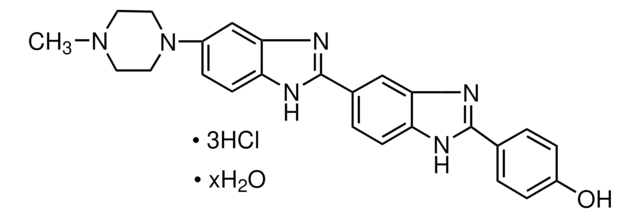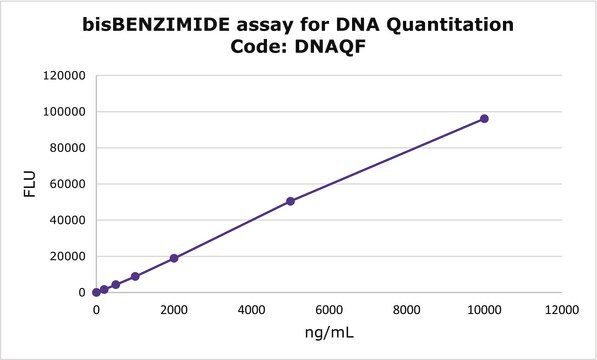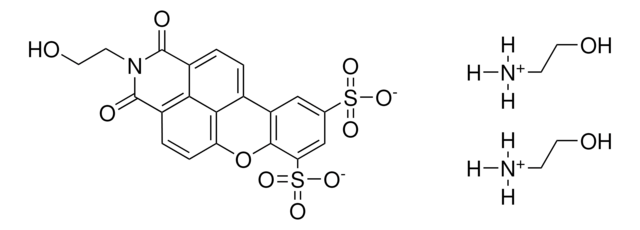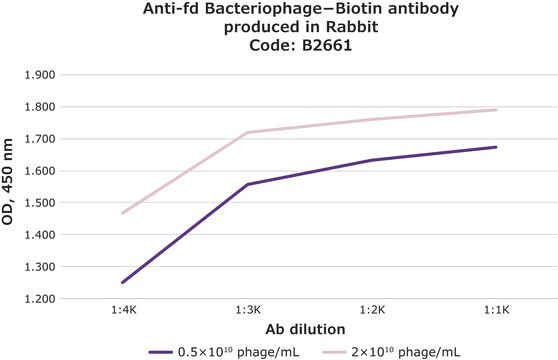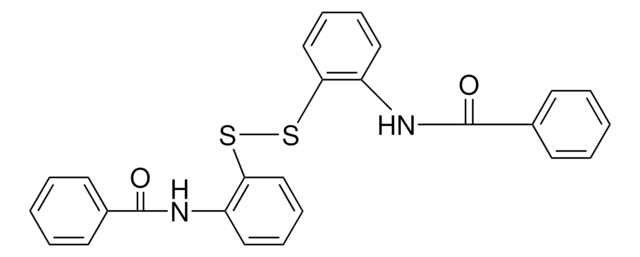B2261
bisBenzimide H 33342 trihydrochloride
≥98% purity (HPLC and TLC), powder
Synonim(y):
2′-(4-Ethoxyphenyl)-5-(4-methyl-1-piperazinyl)-2,5′-bi-1H-benzimidazole trihydrochloride, HOE 33342, Hoechst 33342, bisBenzimide
About This Item
Polecane produkty
product name
bisBenzimide H 33342 trihydrochloride, ≥98% (HPLC and TLC)
Poziom jakości
Próba
≥98% (HPLC and TLC)
Postać
powder
kolor
yellow
pH
1.7 (20 °C)
rozpuszczalność
H2O: 20 mg/mL
phosphate buffer: precipitates
przydatność
suitable for fluorescence
Zastosowanie
diagnostic assay manufacturing
hematology
histology
temp. przechowywania
−20°C
ciąg SMILES
Cl[H].Cl[H].Cl[H].CCOc1ccc(cc1)C2=NCc3cc(ccc3N2)C4=NCc5cc(ccc5N4)N6CCN(C)CC6
InChI
1S/C29H32N6O.3ClH/c1-3-36-25-8-4-20(5-9-25)28-30-18-22-16-21(6-10-26(22)32-28)29-31-19-23-17-24(7-11-27(23)33-29)35-14-12-34(2)13-15-35;;;/h4-11,16-17H,3,12-15,18-19H2,1-2H3,(H,30,32)(H,31,33);3*1H
Klucz InChI
FYEVKHPLBHLWHK-UHFFFAOYSA-N
Szukasz podobnych produktów? Odwiedź Przewodnik dotyczący porównywania produktów
Zastosowanie
Excitation max. = 346 nm
Emission max. = 460 nm
Działania biochem./fizjol.
Właściwości fizyczne
Free dye: Excitation maximum = 340 nm, Emission maximum = 510 nm (5 mM HEPES, 10 mM NaCl, pH 7.0) DNA complex: Excitation maximum = 355 nm, Emission maximum = 465 nm (5 mM HEPES, 10 mM NaCl, pH 7.0)
Uwaga dotycząca przygotowania
Aqueous solutions are stable for 1 month if kept in the dark at 2-8 °C.
produkt powiązany
Kod klasy składowania
11 - Combustible Solids
Klasa zagrożenia wodnego (WGK)
WGK 3
Temperatura zapłonu (°F)
Not applicable
Temperatura zapłonu (°C)
Not applicable
Choose from one of the most recent versions:
Masz już ten produkt?
Dokumenty związane z niedawno zakupionymi produktami zostały zamieszczone w Bibliotece dokumentów.
Klienci oglądali również te produkty
Produkty
Regulation of the cell cycle involves processes crucial to the survival of a cell, including the detection and repair of genetic damage as well as the prevention of uncontrolled cell division associated with cancer. The cell cycle is a four-stage process in which the cell 1) increases in size (G1-stage), 2) copies its DNA (synthesis, S-stage), 3) prepares to divide (G2-stage), and 4) divides (mitosis, M-stage). Due to their anionic nature, nucleoside triphosphates (NTPs), the building blocks of both RNA and DNA, do not permeate cell membranes.
We presents an article on ABC Transporters and Cancer Drug Resistance
Nasz zespół naukowców ma doświadczenie we wszystkich obszarach badań, w tym w naukach przyrodniczych, materiałoznawstwie, syntezie chemicznej, chromatografii, analityce i wielu innych dziedzinach.
Skontaktuj się z zespołem ds. pomocy technicznej


